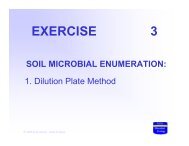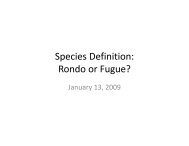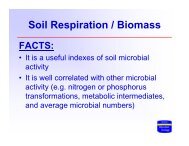Soil Microbial Ecology - Soil Molecular Ecology Laboratory
Soil Microbial Ecology - Soil Molecular Ecology Laboratory
Soil Microbial Ecology - Soil Molecular Ecology Laboratory
Create successful ePaper yourself
Turn your PDF publications into a flip-book with our unique Google optimized e-Paper software.
Page 15<br />
METHOD<br />
This will be a demonstration.<br />
1. Obtain a clear container and label your initial, date, and soil type.<br />
2. Place about 200 ml compost soils (Agriculture or Forest soil) to a mixing<br />
container.<br />
3. Add pond water and stir until it is about the consistency of applesauce.<br />
4. Add 5-g grass cutting for the Agriculture soil and 5-g pine needle cutting for the<br />
Forest soil as a carbon source (carbon source in the form of cellulose).<br />
5. Add equal amount of calcium carbonate and calcium sulfate and mix until the<br />
mixture become drier (source of carbon and sulfur).<br />
6. Pour or spoon this mixture into the Decomposition Chamber to approximately 3-4<br />
cm in depth.<br />
7. Mix it well with a spoon or stirring rod to remove any air pockets.<br />
8. Add plain Agriculture or Forest soil to the respective chamber until the depth of<br />
the soil mixture reaches between 6 and 8 cm. DO NOT STIR!<br />
9. Add pond water, leaving about 4 cm of headspace.<br />
10. Insert a thermometer into the soil and record the starting temperature___ °C<br />
11. The soil column in each Decomposition Chamber should be covered with<br />
aluminum foil, seal with parafilm, and placed next to window.<br />
12. Create data sheet for weekly observations and discussion of the developed soil<br />
layers.





